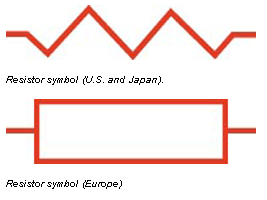The resistor is the most common and well-known of the passive electrical components. There are many uses for resistors: they are used to drop voltage, limit current, attenuate signals, act as heaters, act as fuses, furnish electrical loads, and divide voltages. Resistor 101 tutorial provides an in-depth guide to the types of fixed resistors, their key specifications, and different fixed-resistor technologies.

4 Comments
Kathleen says:
I have seen them and every part of it is really important in most if not all electronic gadget that you will find. Without this I don’t that your televisions will run.
Kathleen from calcul intérêt épargne
Tomi Engdahl says:
Resistor Noise—reviewing basics, plus a Fun Quiz
http://www.edn.com/electronics-blogs/the-signal/4402494/Resistor-Noise-reviewing-basics–plus-a-Fun-Quiz
The noise performance of amplifier circuits is greatly affected by the Johnson noise of resistors—the source resistance and feedback resistors. Most everyone seems to know that resistors have noise but may be a bit foggy on some of the details. Here’s a bite-sized review
Tomi Engdahl says:
“Through thick and thin…film resistors of course”
http://www.edn.com/electronics-blogs/looking—electronics/4411031/-Through-thick-and-thin-film-resistors-of-course-
What is the difference between thick and thin film resistors?
How thick is a thick film resistor?
A traditional dimensional2 dividing line has been ~5μm (~0.2 mils or ~50,000Å Angstrom3). Thick films are typically 10-50 μm thick and thin films are from 10 nm-2 μm in thickness. However, a more functional definition, based on the resistor fabrication technique
“As a result, thick film resistors are generally cheaper than their thin film counterparts, but the tolerance and temperature coefficients one can get out of thin film resistors are generally better. Depending on the materials used, there is plenty of overlap between the two, but all things equal, thin film offer better performance for a cost premium.”
Tomi Engdahl says:
Two-wire vs. four-wire resistance measurements
http://www.edn.com/design/test-and-measurement/4411117/Two-wire-vs–four-wire-resistance-measurements
Most precision digital multimeters (DMMs) and many source measurement units (SMUs) offer both two-wire and four-wire resistance measurement capabilities. However, these two techniques are not equally well suited for all resistance measurement applications. This article offers a quick overview of how to determine the most appropriate technique for a specific application.
Due to the limitations of the two-wire method, a different approach is used for low resistance measurements that reduce the effect of test lead resistance. For measuring DUTs with resistances equal to or less than 1kΩ, test engineers may use the four-wire (Kelvin) connection